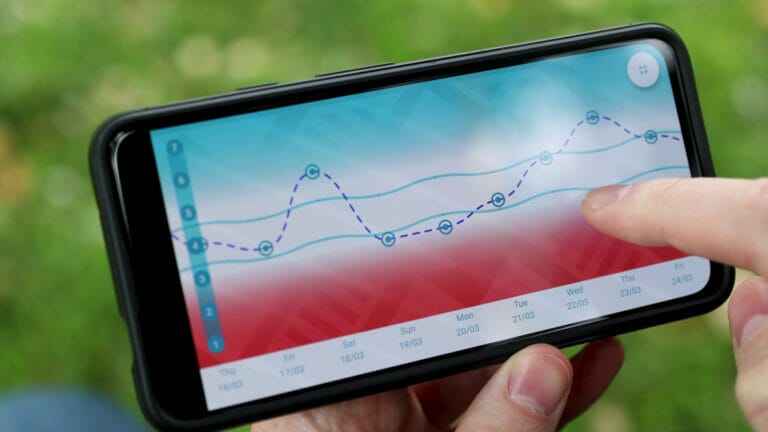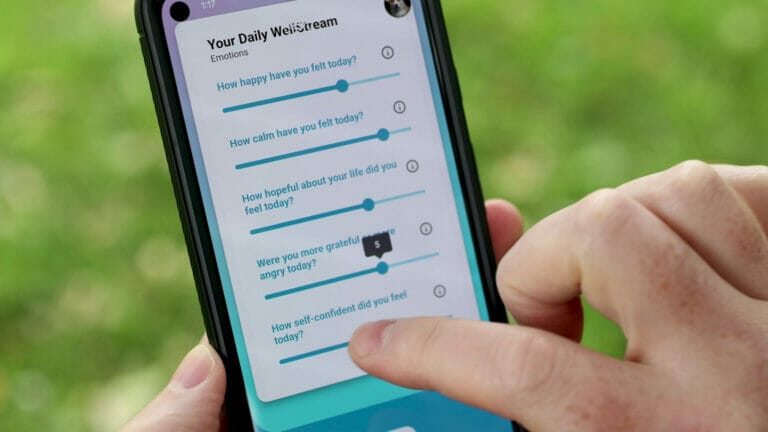How to measure your mental wellbeing in 2023.
10 October, 2023.
Want to learn how to measure your mental wellness and create more health and happiness in your life? Welcome to the comprehensive guide on how to measure, track, and enhance your mental wellbeing, wellness, and health.
In this guide we will cover:
Get WellStream on iOS and Android.
Chapter 1: How to measure mental wellbeing quickly, accurately, and cheaply.
We need to start by defining mental wellbeing. What good mental wellbeing looks like is very subjective but after talking with hundreds of people we think that the following definition works great:
“Mental wellbeing is an empowering state of mind and emotions where you can realise your own abilities and self-worth.
You can cope with the challenges of everyday life, contribute meaningfully where you choose to, and feel reasonably calm and happy as befits your experience.”
This definition forms a continuum where if you have high mental wellbeing then you may feel super-capable, worthy, calm and happy; able to create positive impact for what matters most to you. At the low end of this wellbeing-continuum you could feel the opposite: anxious, unhappy, and incapable. Overwhelmed by everyday life to the point where you feel powerless and worthless. If you have low mental wellbeing right now then we feel for you but don’t worry about it too much – the fact that you are here reading this is a great sign. Wellbeing tends to bounce-back sooner or later and hopefully through this guide you can speed that up!
You now have a definition of the thing that you want to measure and an understanding that wellbeing is a continuum that goes from low to high. Let’s add numbers to the continuum to create a measurement scale for scoring mental wellbeing. We will use a simple 7-point scale where 1 is the lowest wellbeing, 7 is the highest, 4 is a good average, and anything less than a 3 probably feels uncomfortable. Simple.

There is one final thing you need to measure your mental wellbeing on this 7-point scale: a wellbeing quiz. Creating an accurate quiz takes heaps of work, so we’ve done it for you through our WellStream app – available for free on iOS and Android. We’ve spent years developing this app to be fast, convenient, accurate, and true. What’s more it is still the only app dedicated to helping you measure your mental wellbeing so go ahead and install it from the links below or by searching ‘WellStream’ on the app store. The rest of this guide will show you, from first principles, how to use the app to create more happiness and mental wellbeing in your life.

Chapter 2: How often to measure wellbeing and what it may say about you.
Measuring your mental wellbeing regularly will help you to discover the things that make you happy and well, and the things that make you miserable, anxious, or ill. The whole point is to be able to look at a bunch of wonderful happy days and see a pattern of what created that happiness that you weren’t aware of before. The opposite is true as well: finding patterns of what creates terrible anxious days for you, something you might not be consciously aware of yet.
The beautiful, super-powerful, life-changing thing here is that once you know what is good for you and what is bad for you, you can do more of the good stuff and your mental wellbeing can go up. In other words you can make better choices about what to include in your life, cleverly designing a lifestyle that supports you to have great mental wellbeing. It is all about self-awareness.
So how often should you measure your mental wellbeing? Once per day is excellent, 5-times per week is great, 3-times per week is okay.
Daily practice is going to create the most amazing results so the WellStream app is built to be fast. Most people can use the app to measure their mental wellbeing in 60 seconds or less. Another minute to add a diary entry, a photo, and you’re finished for the day. Your time is precious, so we built WellStream to give you maximum power and benefit in the smallest time possible.
But what might the mental wellbeing scores say about you? Well think of it this way – you are either having an awesome time (high scores) or you are having a challenging time with heaps of potential for improvement (low scores). For context, as I am drafting this article in the first week of October, my own mental wellbeing scores have been low, which doesn’t feel great (in the 2-3 range, see my wellbeing river below). My regular baseline (those two smaller ripples) is around a 4 so you can see that this week is an unusually tough one.

What do these low scores say about me? I will share some things I know to be true:
- Things have been happening in my environment that are hurting my wellbeing
- I should try to understand what those things are…
- I need more support than normal this week, from myself and others.
- While my wellbeing is low I need to take care to be kind to other people.
- I need to prioritise doing things that make me feel happy and well.
That is what the low scores say about me. They aren’t a judge of my own self-worth; having low scores do not decrease who I am and vice versa. It is a super-useful sign that I need to put more fuel in the tank and figure out where the leak is. Most importantly it makes me aware of my own need of support from friends and family to help boost me back to normal.
Chapter 3: How to use mental wellbeing measurement to create health and joy in your life.
Now that you have learned how to measure and track your mental wellbeing from first principles, it is time to start creating more health and joy in your life.
A straightforward way to do this is to try something new and measure the impact (positive or negative) on your mental wellbeing. Change is necessary because without it you will likely stay on your current wellbeing trajectory, and nothing will improve. So instead it is wise to make a change, even something small, and see what it does for your happiness and wellbeing.

There are three basic types of changes you can make. You can add something to your life, delete something from your life, or alter something within your life. Some examples are:
- Signing up for a group exercise class at your local fitness centre (adding).
- Blocking a toxic contact who always makes you feel angry (deleting).
- Reading a book in bed each night to help you fall asleep (altering).
If you are a busy person without any time then we recommend first deleting something but if you have a lot of time available then you could add something. Just remember that many people in 2023 are severely burned-out, and it is pointless to add more things to your to-do list when you are already drowning in it. Proper rest solves a lot of problems.
To help you keep track of your changes, and the wellbeing impact they are having for you, we added a fantastic feature to the WellStream app called ‘Streams’. A Stream is simply a change that you are trialling to see if it supports your wellbeing, hence Well-Stream.
Adding a Stream is super easy – there is a great in-app tutorial on how to do it in under a minute. Once you have created your Streams they will be added at the end of the daily wellbeing quiz, and you can simply check which Streams you did each day. The app will then figure out how each Stream may be impacting your mental wellbeing, and how confident it is that the impact is real. You can use that information to design your perfect wellbeing lifestyle.

For example, I recently started cycling again as springtime came to Aotearoa / New Zealand. That first ride in the country made me feel so good and WellStream realised it. The app showed me that cycling had produced a big positive impact on me but needed more data to be sure. Over the following weeks I went for more rides in the country and the app gradually became confident that cycling was in fact more positive for me than running (and easier on my knees too!). So I swapped out running for cycling and can say that I am happier and fitter as a result.
I wouldn’t be surprised if you think creating and tracking Streams sounds boring or academic, because …it kind of is. But it works really, really well. In fact every day WellStream users all over the world are finding new ways to be happier, have more energy, be more loving and creative.

Chapter 4: Potential pitfalls of wellbeing measurement and things you need to be careful of.
Now you have a definition of mental wellbeing that works, a tool to explore it, and a method for creating more happiness and health in your life. You’re all set! In fact there are only a few more things that are worth understanding.
- Your privacy is protected. Over 90% of wellbeing apps make their money by selling sensitive personal data to faceless marketing companies. WellStream doesn’t do that. We encode and protect your personal data to keep you safe. In fact we believe you should own and control all your data on our platform, so you do.
- We make money through subscriptions. You can use WellStream for free but to access the most powerful features requires a paid subscription. This is important because we want to work for you, using subscription income to improve how we help. Enjoy your free trial of WellStream premium and if you love what we do then support us through a subscription, you won’t regret it.
- You are the expert of you. WellStream is powerful but nothing is perfect. It is an incredible tool for building self-awareness and mental wellbeing but always trust your gut.
- Have fun with it. The world is huge, bursting at the seams with potential for happiness and wellbeing. Enjoy the journey and follow us on YouTube so we can journey together.

Chapter 5: TLDR - Measure your wellbeing now on iOS and Android.
The hardest part of mental wellbeing measurement is to know, with confidence, precisely what made you feel happy, calm, angry, or anxious. It’s about validation: knowing the causes behind your emotions; and that’s what WellStream does.
The WellStream app is the fastest, safest, and most advanced way to measure your mental wellbeing. Every day people all over the world are using WellStream to create more happiness and energy for themselves and their loved ones. You are welcome to try it too – find the app through the links below or searching ‘WellStream’ on your phone’s app store.
All new users enjoy a free 14-day trial of WellStream premium.
Ben at WellStream
The author is neither a doctor or psychologist or claims to be.
The ideas expressed in this article are not medical opinions. This article is intended to be useful and informative, not to subvert or replace medical treatments, therapies, or diagnosis. If you are experiencing undue distress please seek medical assistance.
